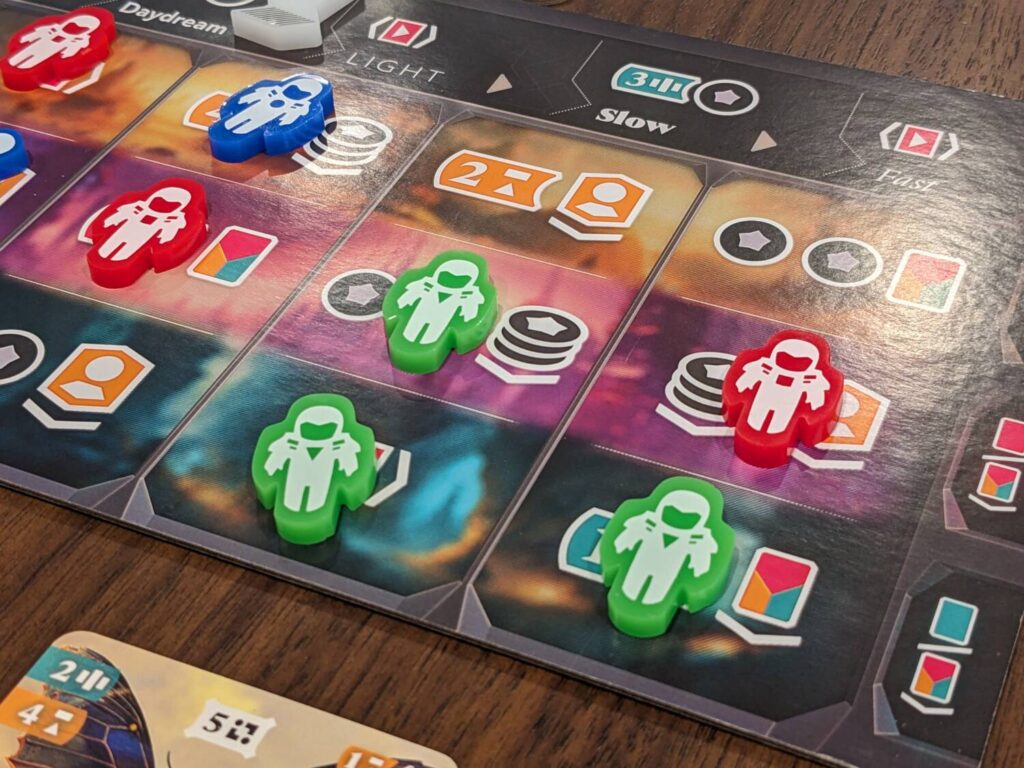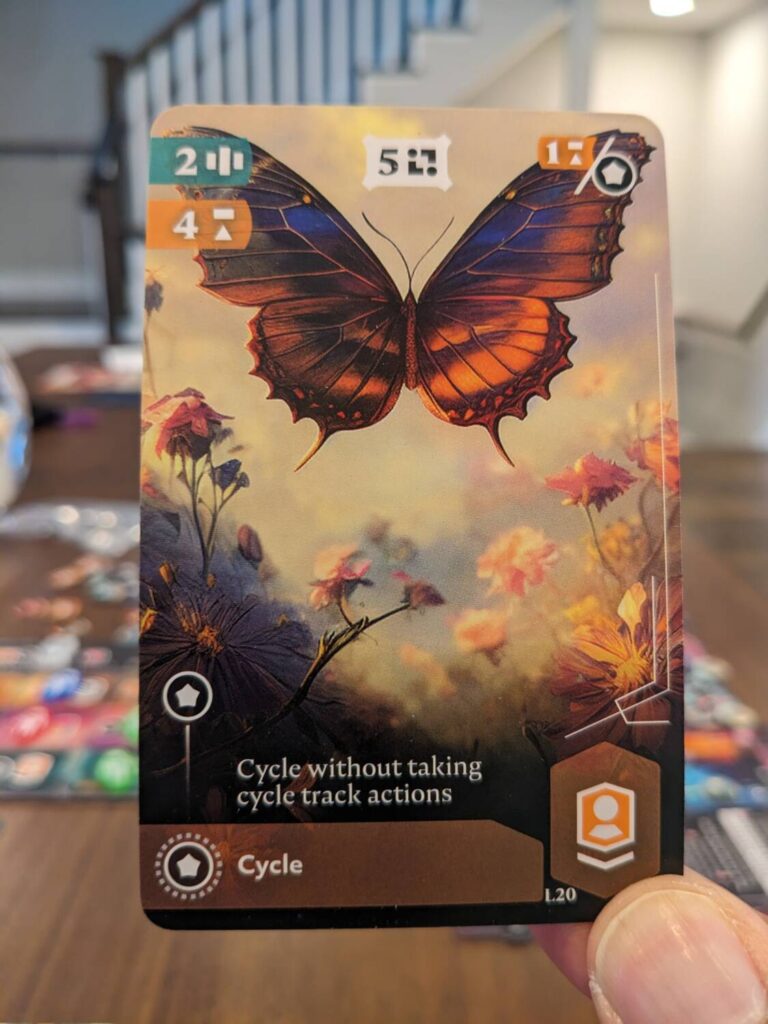Disclosure: Meeple Mountain received a free copy of this product in exchange for an honest, unbiased review. This review is not intended to be an endorsement.
I’m a pretty big fan of Smartphone Inc. and Furnace, the two most popular designs by Ivan Lashin. Both games do a great job of creating simple systems in a playspace that usually runs its cycle in about an hour, with a variety of interesting decisions along the way.
At SPIEL 2024, I had the chance to pick up a review copy of Neodreams (2024, Hobby World), Lashin’s newest creation. The setting for this game was eerily similar to the setup of Virtual Revolution, the Studio H strategy game set in a near future where the business of hosting virtual worlds for customers. In Neodreams, players take on the roles of CEOs who run dreamcasting corporations, hunting for new clients while trying to score the most points by building a card tableau that features images from their new dreamscapes that feel right at home in a fantasy setting.
The core hobbyists I introduced to Neodreams thought it was average fare. In a world where there are dozens, if not hundreds, of similar games hitting the market each year, even lighter fare such as Castle Combo and its 3×3 tableau-building elements resonated more with the same groups in the same week than Neodreams did. But with my family, the skies opened up a bit more, thanks to the gateway approach and variability built into the Neodreams design.

Lucidity
Neodreams is a 2-4 player worker placement game with elements of card drafting and tableau building. On a turn, players place one of their three “Oneirosphere” figures onto a board that has spaces where players can collect resources used to later play cards into their tableau. There are no placement requirements for the cards after they have been purchased, so there’s no tension aligned with where purchased cards secure their final resting place. When a player has built their 12th card, players finish out the round and final scoring is completed.
The game’s main hook within the worker placement structure is tied to the recall action, here known as the Cycle action. Players can either place a worker or Cycle, which initiates a brief clean-up phase where players take back any workers in the current Sleep Cycle column of the board. Players can Cycle even if they have workers left to place, so those actions could happen at any time.
As players take back their workers, they get essentially their only chances to place cards into their tableau by taking the “Returnal” action when their worker comes back to their supply. In many ways, this reminded me of why I love Luke Laurie games such as Andromeda’s Edge and Cryo so much—meaningful action during a clean-up phase or a recall phase is cool, and finding ways to both place workers to take resources then have those same workers swept off the board to trigger a Returnal action is the element I loved most about the Neodreams design.

The three card types that players put into their tableau do the things you might expect in a game of this format. The Lucid deck is full of one-time bonuses that grant a larger boost to resources or placing items on cards to increase both their action powers and their end-game value. Neodream cards are less powerful but allow a player to build an engine that will fire up a small number of times each game to provide a bevy of resources that can be used to play more cards. Recursive cards are all ongoing powers with action-specific text that can trigger at any time.
“Sorry, did you say something?”
Ha, yes, sorry…I did. You see, Neodreams is a fairly heads-down affair as players race to build cards, with powers that only they can see well enough to warrant interaction with anyone else at the table. And any time someone said something in our review crew play of Neodreams, players seemed genuinely surprised. Mostly, players will be talking to themselves as they fire their Neodream engine, or when they place a Client token on a Lucid card to grant a big boost of one of the game’s resources.
And most of the cards ended up being a spin on something else out there. One player’s Lucid bonus might be two Knowledge, two Memory, and two object tokens. Another’s might be three Knowledge, one Fantasy (yes, this is a resource), and two objects. But none of the cards on their own feels broken or game-breaking, which I think would have created more “wow” moments during play.
But for the kids…

“Daddy, I Love the Cards”
My children had a more interesting experience with Neodreams, as did I when gaming with my kids (ages 10 and 8).
So, let’s end here by starting there—Neodreams is a fantastic way to introduce a number of relatively vanilla gaming concepts to future hobbyists like my eight-year-old son. When used as “Baby’s First Worker Placement and/or Tableau Builder”, Neodreams shined brightly. My son picked up the rules lickedy-split and lost our first head-to-head game by only six points, 55-49.
Neodreams lays it out simply—go to space X to grab four Knowledge, then put a worker in the column with the Sleep Cycle marker so that you can trigger a card play action with your next Returnal action. Never place all your workers three columns away from that marker, because it will take forever to get them back. Have a mix of card powers in your display so that you can refill the resource coffers quickly with a powerful four- or five-card Neodream action.
I taught Neodreams to players in about five minutes, so the rules load is light even for someone newer to games. Turns are fast, and games last just as long as the box says they should, or about 30 minutes for two players, maybe 45 minutes for four players. The cards look good—every single adult player thought the art looked like AI art. Even though I know that was not true, I was surprised how consistently this comment popped up. Much like Furnace and Smartphone Inc., Neodreams feels like a luxury product for a value price, with sharp worker tokens and a card finish that shines in all the right ways.
I’m not searching for work as a dreamcasting company CEO just yet, but I enjoyed myself with Neodreams when I had the chance to play it with the kids. But the adults are not asking to play it again, a sign that they were much less enamored with the game than my children. That fits—the action landscape here is limited, and by my second play, I had seen most of the 90 cards in the game. Tension for worker placement spots is not an issue here, which then makes it an issue, right? You want to fight for the best possible actions, but because players will eventually need to take all the actions on the main board, you can almost always find a way to do what is needed.
Neodreams certainly checked the box for me as a quick tableau builder suitable for play with my kids. For a seasoned gamer looking to introduce these concepts to newer players, give Neodreams a look!










